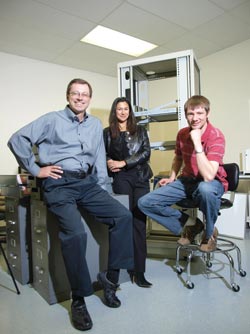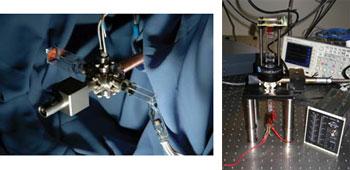John Cowley for Coldquanta Inc.
A Bose-Einstein condensate is a new state of matter that may have been overlooked in your introductory science classes. It is a small cloud of atoms in a high vacuum that behaves as a single atom after being magnetically trapped and cooled to a millionth of a degree above absolute zero. In 1925, this phenomenon was predicted by Satyendra Nath Bose and Albert Einstein.
In 1995, a Bose-Einstein was actually produced, for which Eric Cornell and Carl Wieman, both of the University of Colorado at Boulder, and Wolfgang Ketterle of MIT in Cambridge received the 2001 Nobel Prize in physics. Now, in a movement to produce commercially useful applications, Bose-Einstein condensates are moving out of pure researchers’ laboratories and into mainstream development facilities.
Simplifying the process
A start-up company, ColdQuanta Inc. of Boulder, Colo., is making it easier for interested groups to experiment with Bose-Einstein condensates. It has begun to deliver the RuBECi, a briefcase-size device containing the basic components and environment for creating Bose-Einstein condensates.
The RuBECi was developed at the University of Colorado by a team of scientists and engineers led by Dr. Dana Anderson, who founded ColdQuanta along with Rainer Kunz. Their product reduces the specialized expertise needed to work with “ultracold matter,” helping to spark commercialization of Bose-Einstein condensates. The company’s goal is “to cut developers’ setup time by months or years – and to cut their costs by hundreds of thousands of dollars,” said Kunz, ColdQuanta’s president and CEO.

Pictured are ColdQuanta personnel (from left to right) CEO Rainer Kunz, executive assistant Seema Isabel Hess and senior scientist Dr. K. Jeramy Hughes. Courtesy of Mark Manger.
The RuBECi is a 25-cm-long, brass-and-glass sealed chamber that is optimized for creating Bose-Einstein condensates of rubidium atoms. It includes a rubidium source within its seal. The seal supports the necessary vacuum of 10−9 torr – about a trillionth of an atmosphere – without additional evacuation. A built-in ion pump facilitates the vacuum by removing unwanted ions. The RuBECi’s glass compartments allow laser beams to enter to manipulate the atoms.
A key feature of the RuBECi is an atom chip integrated into the glass chamber. Like a small computer chip, it has a microscopic pattern of conductors formed by standard lithography and electroplating. Powered from outside the chamber, the chip produces currents and fields within the chamber to control the Bose-Einstein condensate cloud and to drive experiments. A Bose-Einstein condensate cloud positioned within 25 to 100 μm of the chip’s inside surface becomes a sensitive detector of field disturbances.

The RuBECi is a device that allows researchers to re-create the Bose-Einstein condensate in the lab just as the Nobelists did at UC Boulder. At left is the naked apparatus, and right is the device hooked up to other equipment needed for its operation. Courtesy of ColdQuanta.
User-supplied external equipment transforms the RuBECi into a working laboratory. Cooling lasers impinging from outside stifle the atoms’ energetic motions and coax them into a trap created by external magnets. Evaporative cooling inside the chamber – releasing the highest-energy atoms – also reduces cloud temperature. Within seconds, the assembly can cool a cloud of 100,000 atoms to the required millionth of a degree.
Promoting new discoveries
Proponents of Bose-Einstein condensate research compare its untapped potential with that of lasers before laboratory-size equipment became miniaturized for thousands of uses. Likewise, easier access to Bose-Einstein condensates is expected to lead to many applications.
Bose-Einstein condensates respond to weak magnetic fields by changing shape. Laser mappings of the clouds’ distortions reveal details of nearby current flows, which could help designers of computer chips better understand the fields within their devices.
The device could be a sensitive magnetometer not only for local fields but also for wider-area radio-frequency fields. After spin-polarization by lasers, the atoms in a Bose-Einstein condensate change polarization in response to specific radio-frequency magnetic disturbances. This modification is revealed by probe lasers. Similar methods could detect weak nuclear magnetic resonance signals, possibly shrinking medical magnetic resonance imaging equipment. They could also detect telltale radio-frequency signals from certain explosives.
In 2000, Lene Vestergaard Hau and her colleagues at Harvard stopped a light pulse by using a Bose-Einstein condensate. More precisely, they stopped the “group velocity” of a passing light pulse by using specially tuned lasers to alter the response of a Bose-Einstein condensate of sodium atoms. Their ability to manipulate light in this way could find applications in optical communications and data processing. Some researchers are thinking of ways to store whole images – briefly – in Bose-Einstein condensates.
Their wavelike properties give rise to additional applications. For example, when set up to perform as atomic interferometers, the phase difference between divided pairs of Bose-Einstein condensates traveling different paths can reveal motion extremely accurately.
Bose-Einstein condensate-based atomic interferometers can measure rotational motion, as laser-based gyroscopes currently do with light beams. Bose-Einstein condensate interferometers offer orders of magnitude more sensitivity than the lasers.
Using interferometry techniques similar to the rotation sensor, Bose-Einstein condensates can measure accelerations with great precision. In their role as accelerometers, they can provide sensitive measurements of gravitational variations, which could aid in geological pursuits such as detecting oil, gas and mineral deposits.
In summary, the RuBECi will make it easier for mainstream researchers and commercial innovators to create products for these and yet-to-be-imagined applications such as quantum computing.
Meet the author
John Cowley is a retired aerospace engineer and freelance writer living in Boulder, Colo.